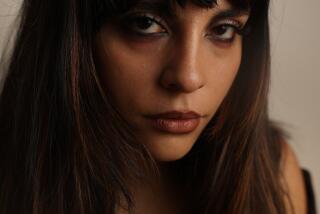The Cover Girls--Singled Out for That Supreme Look
- Share via
Nearly 25 years after the Supremes crooned “Baby Love,” that celebrated Motown trio is still inspiring glamorized, baby-voiced groups--like the Cover Girls.
“Show Me,” the New York-based trio’s first 12-inch single, not only topped the U.S. dance charts last April, but later spent 10 weeks at No. 1 on the Japanese dance charts.
While a second single, “Spring Love,” registered only modest results, a third, “Because of You,” has moved into the Top 30 on the Billboard magazine pop charts. All three singles--and the trio’s debut album--are on Fever Records.
“Before, we were just another dance group with a 12-inch single,” said 5-foot lead singer Louise (Angel) Sabater during a recent interview at the group’s Hollywood hotel, as her partners Caroline Jackson and Margo Urban nodded in agreement. Sabater giggled, unable to contain herself: “Our horizons have broadened, definitely. “
The Cover Girls--who will perform tonight as part of a live radio broadcast at Casa Camina Real, a dance club in downtown L.A.--deal in one of New York’s hottest music forms: Latin hip-hop.
Whereas rap-oriented hip-hop is hard, rugged and muscular, Latin hip-hop is a female-dominated style characterized by the seductive vocal softness of artists like Lisa Lisa, Brenda K. Starr and Expose.
The gritty, urban style, which permeates the airwaves of dance-oriented radio stations such as KPWR in Los Angeles, was popularized by Madonna, whose earliest supporters were black and Hispanic kids caught up in New York’s club scene.
“Madonna didn’t abandon the club scene,” observed Jackson, a former model. “She just took it to the limit. You can go so far in the club scene and then you’ve got to cross to that next level.”
Producers who worked on the Cover Girls’ album (also titled “Show Me”) included men like Tony Moran and Albert Cabrera (known professionally as the Latin Rascals), Andy (Panda) Tripoli and (Little) Louie Vega--all of whom worked as club deejays/mixmasters.
“We mostly interpret their ideas,” said Sabater. “I mean, nobody expected ‘Show Me’ to hit so big. So the album was done quick--we finished it in two months. There wasn’t time for us to put in any of our own ideas.”
The Cover Girls’ look--a combination of voluminous hair, lithe bodies and clingy costumery--was conceived by Fever Records president Sal Abbatiello and producer Andy Tripoli, both of whom felt the time was ripe for an ‘80s-style, fashion-conscious girl group in the Supremes tradition.
It took a year of auditioning hundreds of young women from the Bronx, Brooklyn and Queens before they arrived at the current aggregation: three girls in their early 20s (they decline to give their exact ages) who not only sing but possess the look. Or, at least, were capable of possessing the look.
“Hey, I never wore makeup before joining this group,” Sabater confided.
Urban, who recently replaced original member Sunshine Wright (a former Elite model who quit the Cover Girls to resume her modeling career), said she was familiar with the trio “through my brother. He used to play ‘Show Me’ 20 times a day.”
No one in the group agreed with the notion that being a manufactured “concept” might diminish their commitment to the enterprise. “You wouldn’t get into something like this unless music was a ‘forever’ kind of commitment,” said Jackson.
Though the group was largely shaped by men, Jackson feels the Cover Girls’ success is a sign of greater involvement by women in the entertainment world.
“You see more of us doing things now,” she said. “There are women writers, producers, even club owners. You didn’t see much of that before. And it isn’t just guys who like the Cover Girls. Women like us. They like our style.”
More to Read
The biggest entertainment stories
Get our big stories about Hollywood, film, television, music, arts, culture and more right in your inbox as soon as they publish.
You may occasionally receive promotional content from the Los Angeles Times.










